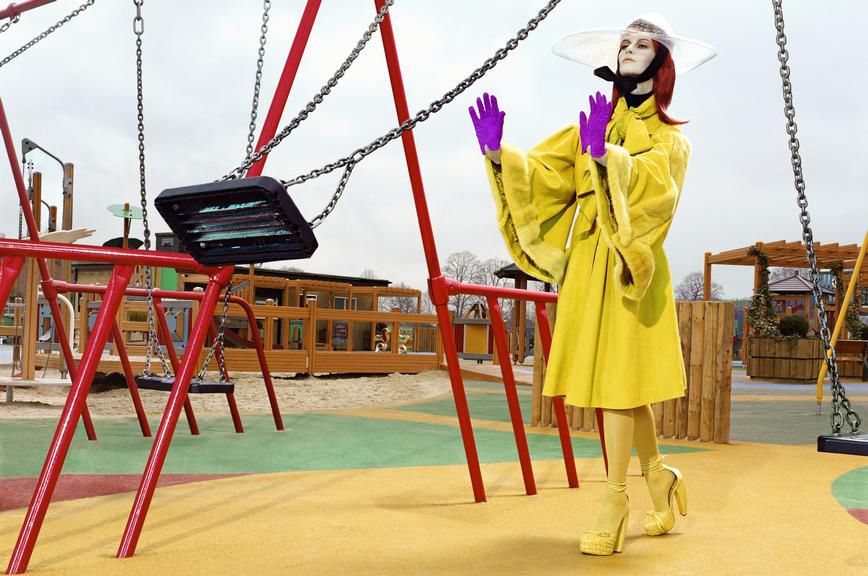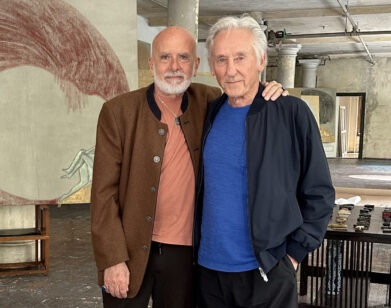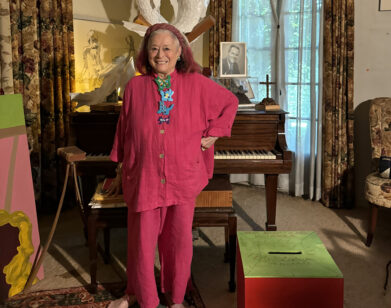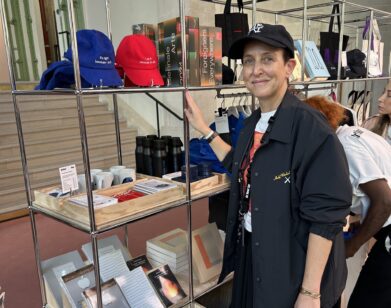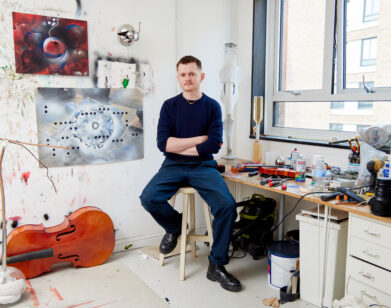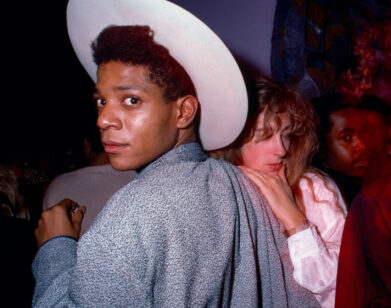Miles Aldridge Keeps Building the Mystery
Having arrived at a 15-year sweet spot in his fashion photography career, Miles Aldridge is continuing to do what he likes to do; eschewing pretty images of pretty women in pretty situations. His is an intensely personal story: a life spent surrounded by model sisters, a successful yet wayward illustrator father, and a glamorous but suffering mother. Through the lens, he constructs a graphic, deep dream world, wholly focused on his fascination with the “mystery” of women; a discontent and bewilderment that belies their seemingly perfect universes. “I am the very best person to take my pictures,” Aldridge says.
In London, at least, this month belongs to Aldridge, with celebrations thrice over town: “I Only Want You to Love Me,” a retrospective put on by Somerset House; a monograph by the same name, published by Rizzoli (with a foreword by Glenn O’Brien); and a small gallery exhibition of limited-edition works at Brancolini Grimaldi. All three reveal his inimitable ability to create cinematic pictures, which chart a place between attractiveness and unease, in what O’Brien classifies as “high glamour photo fiction.”
Aldridge’s is a tale well told: the pictures he took of his first model girlfriend kick-starting his career by way of British Vogue in the ’90s, and a long list of intimidating supermodel names—Linda Evangelista, Anja Rubik—succeeding. His is a postmodern universe, “apt for now,” where his colourful, couture-clad subjects, photographed in playgrounds, supermarkets, showers, or in fast cars, is a place where more is still more. A strange beauty, which sidesteps all the clichés, suggests beneath their “vacant” stares that endless consumerism is merely a short-lived antidote that can’t erase the inner doubt behind their external beauty.
For this celebratory retrospective, Aldridge includes previously unpublished photographs, drawings, scribbled notes, casual tears, storyboards, and Polaroids. Though he still calls himself an “amateur” player “shy” with women, the book is reflective of the maker himself: direct, dynamic, engaging, imaginative, inquiring, sophisticated, considered, and complex.
This conversation took place over the phone at night in London, when Aldridge had just arrived back from shooting a couture story in Paris, a couple of days before the retrospective and exhibit opening.
DAVINA CATT: So this marks 15 years for you as a photographer. How does it feel—like a summing up, even a reckoning, maybe?
MILES ALDRIDGE: I feel fairly satisfied and that the direction of my work has been a course worth pursuing, I suppose. I think the book is a very good manifesto of the last 15 years of my work, and hopefully a testimony of the times I live in. When I began in the late ’90s, I felt quite lonely. We were coming out of the grunge era; it was the time of Corinne Day, The Face, the height of the YBAs, where models had to be “real,” on real locations with no lighting. I rebelled against the grungeys—I didn’t find the faux naturalism to be representative! I had been reading a lot of J.G. Ballard at the time and was fascinated by the idea of the vapid consumer society, the erotic charge of modern life, where the consumerist things we are coveting are just another form of destroying oneself—a modern world of uncertainty, where lost souls are trying to grab onto something for sense of contentment. I did a series of dark, desperate women based on it—there was resistance to what I was saying, my exhibitions weren’t being well received, and then 9/11 happened, and I said to myself, “Have I gone too far?” Now I look back and realize going out on a complete limb at the time was right—well, people seem to be really responding to my message now, anyhow!
CATT: Will you miss anything about working towards this point, or is it a relief to be finished?
ALDRIDGE: Having a book is actually like a great master—helping to build a universe and unify work—especially in my pictures where there is such a strong signature, yet with a set of rigorous rules to it. I’m always working in this universe—whether picturing hamburger joints, Virgin Marys, domestic scenes—using these “vacant-faced” women as a medium to question universal truths. I suppose I like to set myself projects that are tight, focused, and then challenge myself with how broad I can go within that limited aspect. I think to Helmut Newton and film director, Federico Fellini—the added level of eroticism, the arousing message—and how it was possible for them to keep their signatures over so many years.
CATT: Looking at these troubled, wounded women—I know there is always an autobiographical element in your fascination and vision of them, but you specifically cite your mother as muse for “I Only Want You to Love Me.”
ALDRIDGE: Yes, she died very suddenly when I was in my mid-20s. It was like she there was there and then gone. There is this line from a song by The Cure, which says it best: “No one ever knows or loves another.” I was left with an enigma as to who she really was. I suppose she paved the way, the first of many enigmatic women who have gone onto be part of my life. Fifteen to 20 years later, I found myself really thinking who she was; it is like being left with detritus and you need to put the puzzle pieces together, so yes, she is in the women in my pictures. I look at my women with a Shakespearean element too—the variant of emotions they are capable of—it’s not all completely dour, there is a bit of humor in there too! I actually think the whole Shakespearean world is wrapped up in every human being, from beauty to destruction and everything in between.
CATT: Are there any other autobiographical elements woven in?
ALDRIDGE: Yes, I think in two ways. When I look at the women, it’s from a male gaze of being fascinated, because beyond my mother, I’ve been around notorious women all of my life, and then, secondly, when I look at women and try and create fictional stories around them. I’m inspired heavily by film influences—Lynch’s Blue Velvet, Fellini, Hitchcock, Almodóvar, and what I see in the cinema—so there is a linking, an interweaving between memory, cinema and contemporary life, which the women in my pictures encapsulate.
CATT: As a viewer, your images certainly draw you in.
ALDRIDGE: I think the power of image is in mystery—I endlessly create mysteries, by way of this dystopian message, to initiate intrigue. I want the viewer to be like a voyeur—look at the power of old Hollywood actresses, who sometimes weren’t even making eye contact—but unlike film, an image can catch the combination of how we are and how we want to be. I suppose even though it does feel like my world, I am happy to be a magpie!
CATT: You also include unpublished material and for the first time the drawings—your initial starting point for work. Why did you decide on this?
ALDRIDGE: I like the drawings. And as a photography fan myself, I would look at Newton or Penn and like to see the initial notes or drawings, to see where the ideas grew from. Also my sketches are key to my work because I came to realise early on that by doing drawings, I could formulate a plan of what I was thinking of—I could take control and direct the work. It’s amazing how if you turn up at a studio without an idea, a picture will take itself from momentum, and you quickly can lose control.
CATT: What is your personal favourite image featured?
ALDRIDGE: It would have to be “Immaculée”—Alana Zimmer as the Virgin Mary [above, at beginning of slideshow]. The concept was very actually very simple; a combining of a sexual ecstasy and religious ecstasy in the picture—but the whole collaboration just really clicked. There is a chapel especially designed as part of the Somerset House retrospective for those five images alone. I’ll always remember Jean Paul Gaultier, who did a project based on Madonnas, remarking on the images, “Yours are much better.” Gaultier is really smart, so it’s good getting a compliment from him! [laughs]
CATT: I was drawn to Glenn O’Brien’s words in the foreword: “Planet Aldridge is a luxury world where surreality reigns. All is perfect, yet something is amiss. Life is fashion, after a fashion, but this is hardcore fashion, the end of the luxury road.” You mentioned to me once previously this was the unhappiest your women have ever been. So where can they go from here, now they’ve got everything they’ve been chasing after?
ALDRIDGE: It’s a big mystery. I’ve been so deep in thought about this book and this point, I really haven’t thought about the next move. After this I am going to have to pause, sit down and really consider it. In a way, though, the work is never finished because women forever will be eternally mysterious to me—and I will always find that point where people are lost in thought, observed but lacking self-consciousness, the most beautiful. I’ve thought in the past about moving into film, making these women move, but I am not sure it’s really me to weave a whole story.
CATT: And how do you see the next 15 years as a photographer?
ALDRIDGE: Well, all work included in the book and exhibitions is shot on film—I love the way color and women come together and look on film—which I haven’t found to be the case on digital. I’ve stuck with film but am curious if that will still be the case in 15 years. I might not still be riffing on the same sarcastic message—they could end up actually happy! You never know! [laughs]
“MILES ALDRIDGE: I ONLY WANT YOU TO LOVE ME” IS ON DISPLAY AT SOMERSET HOUSE TODAY THROUGH SEPTEMBER 12, AND THE MONOGRAPH OF THE SAME NAME IS AVAILABLE NOW FROM RIZZOLI. “MILES ALDRIDGE: SHORT BREATHS” OPENS AT BRANCOLINI GRIMALDI THIS FRIDAY, JULY 12, AND RUNS THROUGH SEPTEMBER 28.

